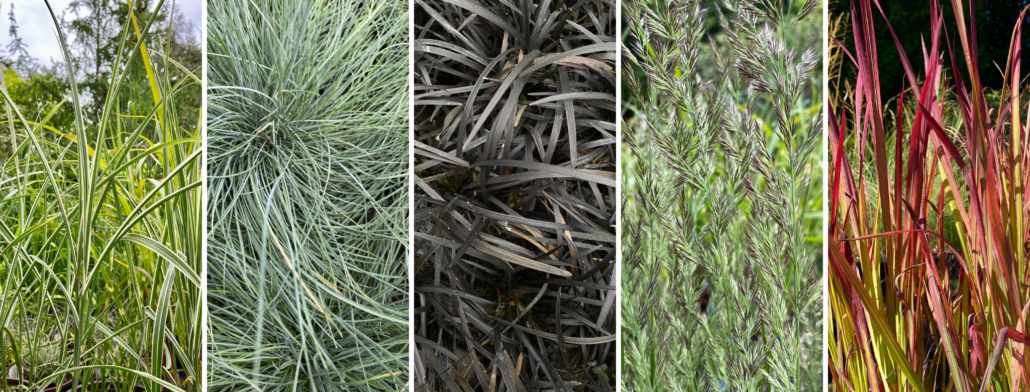Even with nine months of rain, Pacific Northwest summers can be challenging for gardeners because of the lack of water. Any plant will need a few years of water to become established, but once they are, there are a number of plants that will thrive without much irrigation. Here are a few ideas for shrubs, perennials, and trees that thrive in the Pacific Northwest, without a lot of irrigation.
Shrubs
Pacific Wax Myrtle (Morella californica) – This easy, adaptable shrub is a Pacific Northwest native and can thrive in nearly all light conditions from full sun to full shade. Its evergreen nature makes it a perfect backdrop plant in the garden, or to form an excellent hedge. It takes pruning well but can also grow into a 10’- 15’ small tree if desired. In late summer it will produce clusters of small black fruit which last until midwinter. Birds love it! It performs best in well-draining soil but can also tolerate sandy and clay soils. This deer-resistant native is a ‘great plant pick’ for the pacific northwest, and with good reason!
Strawberry Tree (Arbutus Unedo) – Here’s to a shrub that has it all – showy fruit, flowers, bark and evergreen leaves! From October to December the shrub is covered in clusters of small, white flowers with fused petals (like a blueberry’s flower). Alongside the flowers are large round fruits that ripen from orange to red. The combination of the flowers and fruit together is quite stunning and will attract pollinators. The leaves are a beautiful dark green which goes well with the mottled, cinnamon-colored bark. This shrub grows best in full sun but will tolerate some shade.
Alpine Mint Bus (Prostanthera cuneata) – Just as the name implies; this small Australian native has a wonderful minty fragrance. The tiny leaves are evergreen and will only grow to a little over 1-foot-tall. It is resistant to deer, slugs and snails and aphids; yet is irresistible to bees and butterflies. It flowers late spring or early summer with small orchid-like flowers.
Dawin’s Barberry (Berberis darwinii) – My favorite barberry! This evergreen barberry is native to Chile and was discovered by Charles Darwin in the voyage of the ‘Beagle’. It is very tough, and will keep a compact habit when grown in full sun. It can reach over six feet and very little pruning is needed. The unique part of this barberry is the flowers. In early March, the shrub will be covered in reddish/burnt orange buds that open to vibrant orange flowers. Truly stunning! The leaves contrast perfectly with the flowers, having a rich dark green color with a shiny finish. To top it off, it’s deer resistant and attracts bees, birds, and butterflies!
Rockrose (Cistus x hybridus) – This is a shrub that actually thrives best with neglect! Full sun, hot sites, and well-draining, sandy soil is the sweet spot for this evergreen shrub. The more water the plant receives, the more susceptible it is to flopping and winter damage so the less water the better! This shrub is a wonderful problem-solver because it can tolerate salt spray making it a great choice for coastal gardens. The white rock rose is the hardiest of the group, but it does come in several shades of pink as well. It becomes covered in papery, large flowers in the spring, which attract bees and butterflies.
Perennials
Sedums – I can’t write a blog about drought-tolerance without mentioning sedums! These problem solving perennials come in all colors, from vibrant lime green foliage to brilliant blue-grey to rich dark purple. Sedums are often grown for their foliage, yet some species such as Autumn Joy and Vera Jameson have beautiful upright bright pink flowers in the fall. All sedums are a type of succulent; which in botany means they have thickened, fleshy leaves which help retain water. Sedums can actually store water in their leaves! They thrive on poor soils with very little water. They make a great container for those that don’t want to water much in the summer!
Sun Rose (Helianthemum nummularium) – This evergreen perennial looks like a miniature cistus with grey-green leaves and small delicate flowers. The plants put on a big show late spring with scattered blooms throughout the summer. It grows low, only about a foot tall, but will spread to a nice clump, 3’ around. My favorite variety is ‘Henfield Brilliant’ because of its outstanding orange color, but it comes in a number of other colors, including pink, yellow, red and peach. Bees and butterflies are attracted to the bright colored flowers and the greyish foliage makes a great contrast. Hot sunny locations will encourage profuse blooming!
Yellow Wild Indigo (Baptisia ‘Carolina Moonlight’) – This perennial resembles lupine with spikes of butter-yellow flowers. It will form a 4’ clump with flower spikes reaching 4’ as well. This perennial is very easy to grow without any major health issues. It will grow best in full sun, well drained soils, but will tolerate clay soil. It will flop if given too much water or grown in too rich of soil. This means the poor soil, hot locations of your yard are perfect for it to thrive!
Twirling butterflies (Gaura lindheimeri) – This wildflower is native to Arizona, making it a great choice for a drought-tolerant landscape. It grows to nice 3’ clump, sending out tall spikes of pink or white flowers. The flowers bloom along a wand-like stem creating an airy, graceful texture which is perfect for a border. The newer forms of Gaura have red-variegated leaves making it attractive even when out of bloom.
Russian Sage (Perovskia atriplicifolia) – This hardy, deer resistant perennial sends out airy, upright spikes of grey-purple flowers from August to September, adding late season color to your garden. The foliage is a bluish grey which is a nice contrast to surrounding green foliage. The flower spikes will finish blooming in the fall, but the silver stems can be left through winter to add interest. The plant can reach up to 4’ tall, and form 3’ clumps.
Giant Feather Grass (Stipa gigantea) – This grass has been described as a well behaved pampas grass. It sends out exquisite tufts of 8’ seed heads topped with dangling, honey-colored seeds. The grass will hold its seed head form early summer to late fall, and removed once they become damaged by winter weather. Its airy nature make it ideal for a border or as a center piece in a garden. It is deer resistant and tolerates full sun and sandy soils.
Trees
Vine Maple (Acer circinatum) – A wonderful Pacific Northwest native with a multi-stemmed growing habit. These maples are closely related to Japanese maples and have great fall color and grow to only 15’-20’ tall. They turn a lovely orange in the fall, and keep their color throughout the fall season. This delightful little tree is especially popular in urban gardens where space is limited. It can grow in nearly all soil conditions, sandy, clay, moist or well drained.
Maidenhair Tree (Ginkgo biloba) – Considered a ‘living fossil’, Ginkgo trees evolved over 200 million years ago! They have unique, fan shaped leaf with a scalloped outer edge. It has outstanding fall color of rich gold and is considered one of the most beautiful deciduous trees. It is so hardy it is often grown as a street tree on bluffs with salt spray and cities with bad pollution problems. The female ginkgo can produce fruit with awful odors so make sure to buy a male. Very little pruning is required because it has such a nice branch structure. With all these traits, who wouldn’t want a living fossil in their garden!
Golden Locust (Robinia pseudoacacia ‘Frisia’) – This tree has outstanding foliage. The leaves are a bright lemon-yellow which will brighten any landscape from spring to fall. The more sun the tree receives, the brighter yellow the foliage, however in partial shade the leaves will turn a lovely chartreuse. Each leaf is about a foot long, and made up of over 20 separate leaflets. The bark becomes gnarled overtime and the tree will eventually grow to 50’ tall.
Persian Ironwood (Parrotia persica) – This witch hazel relative is a 4 season tree. The unique branch structure and peeling grey bark adds winter interest. It flowers before the leaves just like a witch-hazel. The flowers are tiny and spider-like and appear in late winter. The large scalloped leaves emerge in the spring, and start their outstanding fall display in August. They turn bronze then bright crimson before they fade to orange and finish their show in October with a bright gold color.
Spanish Fir (Abies pinsapo) – One of the most majestic species of conifer, this Spanish fir is disease resistant and evergreen. It will perform best in full sun and well-draining soil and once established is heat tolerant as well. The needles on the fir are radically arranged, meaning the needles cover the entire branch. This will add an architectural element to your garden! The blue-green color provides interest year round, and contrasts to surrounding green foliage. In the spring the tree produces small red cones at the tip of the branches. There is a new variety out named ‘Aurea’ which has golden colored new growth, adding even more reason to grow this rare conifer.

